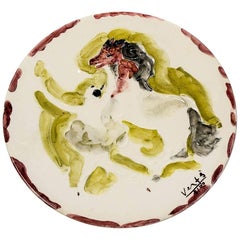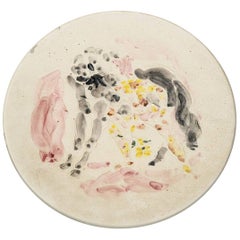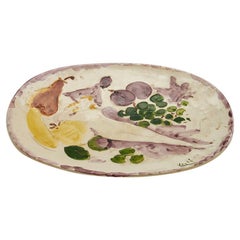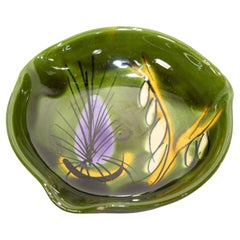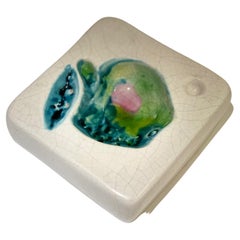Marcel Vertès Decorative Dishes and Vide-Poche
Hungarian, 1895-1961
Emmanuel Marcel Vertès, born Vértes Marcell in Újpest (Hungary) on 10 August 1895 and died in Paris 16th arrondissement on 31 October 1961, was a Hungarian-born French painter, engraver, illustrator and costume and film designer. After studying with Ferenczy at the Beaux-Arts in Budapest, Marcel Vertès produced political posters during the First World War. Going into exile at the end of the hostilities, like his comrades Mihály Bíró and Róbert Berény, he studied at the Académie Julian in Paris. He made a name for himself in France in the mid-1920s, particularly for his lithographs and illustrations. He published L'heure exquise, a series of erotic engravings, followed by Le pays à mon goût. His favourite subjects were the circus, balls and brothels. His real fame came with an album of lithographs entitled Dancings. Among the works he illustrated were Chéri and La Vagabonde by Colette, L'Europe galante by Paul Morand and Le Cirque by Ramón Gómez de la Serna, published by gallery owners Madeleine and Pierre Trémois. He was associated with the Hungarian cartoonist Alex Szekely.
In the 1930s, he also worked for fashion magazines such as the English edition of Vogue, the American rival Harper's Bazaar and the Gazette du Bon Ton. An engraver, watercolourist and costume designer, this artist also collaborated with Elsa Schiaparelli on numerous occasions, including advertising campaigns for perfumes, the creation of fabrics and even a portrait of the couturier. Mobilised at the start of the war, he was demobilised the following year and left for Biarritz. After passing through Spain, he returned to New York with his wife shortly afterwards and settled in 57th Street, continuing his collaborations and illustrations with the fashion world.
In the early 1950s, Marcel Vertès enjoyed a high profile in artistic circles, justified by a talent often described as exceptional. His drawings were characterised by a great economy of line and colour, and he also produced illustrations in black and white.
It was during this period that he worked on John Huston's Moulin Rouge as costume designer and set designer. He won two Oscars for this film. He moved back to Paris in the late 1950s and died there in 1961.
He is buried in the Père-Lachaise cemetery (90th division).to
3
3
3
3
1
1
3
2
1
3
3
Height
to
Width
to
3
3
3
39
47
37
34
26
Creator: Marcel Vertès
Marcel Vertes Beautiful Ceramic Dish to the Prancing Horse, circa 1950
By Marcel Vertès
Located in Saint-Ouen, FR
Beautiful ceramic dish by Marcel Vertes, Vallauris Tapis Vert Manufacture, circa 1950, signed,
in perfect condition.
Category
1950s French Modern Vintage Marcel Vertès Decorative Dishes and Vide-Poche
Materials
Ceramic
Marcel Vertès Beautiful Ceramic Dish to the Horse, circa 1950
By Marcel Vertès
Located in Saint-Ouen, FR
Beautiful ceramic dish depicting a horse, Vallauris, tapis vert manufacture, circa 1950, signed,
in excellent condition.
Category
1950s French Mid-Century Modern Vintage Marcel Vertès Decorative Dishes and Vide-Poche
Materials
Ceramic
Colorful Ceramic Charger by Marcel Vertès
By Marcel Vertès
Located in Montreal, QC
Colorful glazed ceramic charger, " Nude in a still life" "Tapis Vert" by Marcel Vertès,. Signed "Vertès" , Edition du "Tapis Vert" , piece originale .
Category
1950s French Vintage Marcel Vertès Decorative Dishes and Vide-Poche
Materials
Ceramic
Related Items
Vallauris Green Ceramic Dish France 1950
By Vallauris
Located in Moreno Valley, CA
Vallauris Green Ceramic Ashtray, Dish France 1950.
Small french glazed ceramic dish with abstract design, signed Vallauris to base.
Beautiful green glazed ceramic ashtray with colorful abstract design manufactured by Vallauris.
This ashtray was handcrafted in France in the 1950's.
Hand painted in purple green and yellow glazed ceramic on a dark olive green background.
Use it as an ashtray or catchall, useful as jewelry bowl or vide-poche.
Signed Vallauris at the bottom.
Overall dimensions: 6.5 in x 6 in x 1.75 in height.
About Vallauris.
Vallauris Golfe Juan is a tourist town of the French Riviera near Antibes known as the "city of 100 potters". Its name (Valauria in Provencal) means "the golden valley...
Category
Mid-20th Century French Mid-Century Modern Marcel Vertès Decorative Dishes and Vide-Poche
Materials
Ceramic
Georges Jouve Ceramic "Apple" Dish, 1950s
By Georges Jouve
Located in Paris, FR
Georges Jouve's Ceramic cup or vide-poches " La pomme " signed Jouve & apollon mark on back in deep enamel.
White cracked enamel with a turquoise/green/pink apple
Measures: 17 cm ...
Category
1950s Vintage Marcel Vertès Decorative Dishes and Vide-Poche
Materials
Ceramic
Marcel Fantoni Italian Ceramic Fruit Bowl Midcentury
By Marcello Fantoni
Located in Philadelphia, PA
This Marcel Fantoni ceramic fruit bowl is a beautiful round piece glazed in a mat ochre base with an abstract gown design and orange ring.
Category
Mid-20th Century Italian Mid-Century Modern Marcel Vertès Decorative Dishes and Vide-Poche
Materials
Ceramic
Vintage Daum Art Deco Crystal Fruit Dish
By Daum
Located in LA CIOTAT, FR
A spectacular Art Deco style crystal fruit dish, from the legendary French Daum cristallerie. Constructed in an undulating Freeform design, this wonderful, heavy, vintage piece is in...
Category
20th Century French Art Deco Marcel Vertès Decorative Dishes and Vide-Poche
Materials
Crystal
20th century design black ceramic dish or vide poche att. to Pol Chambost 1950
By Pol Chambost
Located in Neuilly-en- sancerre, FR
Att. to / in the style of Pol Chambost
20th century design black ceramic cup or vide poche
Realised circa 1950
Original perfect condition
Height 5 cm
Large 16 cm
Depth 15 cm
Category
Mid-20th Century French Mid-Century Modern Marcel Vertès Decorative Dishes and Vide-Poche
Materials
Ceramic
$1,309
H 1.97 in W 5.91 in D 6.3 in
French Majolica Fish Dish Circa 1950
By Vallauris
Located in Austin, TX
Small French Majolica fish platter Vallauris Circa 1950.
Category
1950s French Mid-Century Modern Vintage Marcel Vertès Decorative Dishes and Vide-Poche
Materials
Ceramic
Roger Capron French Ceramic Black and White Cache Pot or Vase, Circa 1956
By Roger Capron
Located in Chicago, IL
Roger Capron French ceramic artist black and white ceramic vase with decoration termed scarification.
Similar ceramic pieces pictured on p 69 of Roger Capron Ceramist by Pierre Sta...
Category
1950s French Mid-Century Modern Vintage Marcel Vertès Decorative Dishes and Vide-Poche
Materials
Ceramic
John Glick Plum Street Pottery Ceramic Charger Monumental
By John Glick
Located in Bloomfield Hills, MI
The ceramic charger is an example of the kind of work by which John Glick became so famous. He was seduced by the effects of the reduction kiln, which decreased the levels of oxygen during firing, inducing the flame to pull oxygen out of the clay and glazes changing the colors of the glazes depending on their iron and copper content. In this way he achieved the rich gradients of ochre and umber and variations in stippling and opacity. It is signed by the artist and stamped with Plum Street Pottery #129 on the verso.
John was an American Abstract Expressionist ceramicist born in Detroit, MI. Though open to artistic experimentation, Glick was most influenced by the styles and aesthetics of Asian pottery—an inspiration that shows in his use of decorative patterns and glaze choices. He has said that he is attracted to simplicity, as well as complexity: my work continually reflects my re-examination that these two poles can coexist… or not, in a given series. Glick also took influences from master potters of Japan, notably Shoji Hamada and Kanjrio Kawai, blending their gestural embellishments of simple forms with attitudes of Abstract Expressionism. He was particularly drown to the work of Helen Frankenthaler whose soak-stain style resonated with Glick’s multi-layered glaze surfaces, which juxtaposed veils of atmospheric color with gestural marks and pattern. He spent countless hours developing and making his own tools in order to achieve previously unseen results in his work with clay and glaze.
Glick’s “Plum Tree Pottery” (now a designated historic landmark in Farmington Hills, Michigan) studio opened around 1965 and closed in the summer of 2016. It was a private studio space for John and a number of his students and assistants. He believed his shapes evolved guided by forces apparently outside his control. This was instinctual, intellectual and due to his openness to change, fusing into what he thought was the most positive force behind a potter’s approach: evolution and growth. Some have called it inspiration.
John was not only a major figure in the Detroit creative community, but in the ceramics world at large. According to Shelley Selim in her book on John, “John Glick: A Legacy in Clay” John remains: “one of the most recognizable names in the field of studio pottery – known for lecturing, publishing, and offering workshops widely – and his work has been featured in well over a hundred local, national and international exhibitions since he was a college student in the late 1950s.” Along with this John has mentored over thirty studio apprentices over five and a half decades, received numerous grants and awards for his work, and has been prolific, with an estimated 300,000 ceramic wares throughout the world.
He received his Masters from Cranbrook Academy of Art in Bloomfield Hills, Michigan, working with Maija Grotell, a legendary and influential teacher. Grotell was noted for her deep interest in the human connection to nature’s rhythms and patters. These ideas often grounded her dialog with her students including Glick, affecting, a profund and lasting influence on his future work. This famous Art Academy was designed by architect and faculty member, Eliel Saarinen who collaborated with Charles and Ray Eames on chair and furniture design. Numerous creative artists who are alumni of Cranbrook include: Harry Bertoia, Florence Knoll, Jack Lenor Larsen, Donald Lipski, Duane Hanson, Nick Cave, Hani Rashid, George Nelson, Urban Jupena (Nationally recognized fiber artist), Artis Lane (the first African-American artist to have her sculpture, "Sojourner Truth," commissioned for the Emancipation Hall in the Capital Visitor Center in Washington DC), Cory Puhlman (televised Pastry Chef extraordinaire), Thom O’Connor (Lithographs), Paul Evans (Brutalist-inspired sculpted metal furnishings), Eugene Caples (small bronze images/abstract), Morris Brose (Bronze Sculptures), Herb Babcock (blown glass), Larry Butcher (mixed media) and Lauren Anais Hussey...
Category
1990s American Expressionist Marcel Vertès Decorative Dishes and Vide-Poche
Materials
Ceramic
Round deep ceramic dish, Sainte Radegonde, circa 1940
Located in New York, NY
Origin
Sainte-Radegonde, France, circa 1940s
Materials
Glazed ceramic
Dimensions
11.5in diameter, 4in height
Condition
Very good vintage condition, consistent with age
A sculptur...
Category
Mid-20th Century French Mid-Century Modern Marcel Vertès Decorative Dishes and Vide-Poche
Materials
Ceramic
Lotuso Sea Ceramic Decorative Bowl by Simone & Marcel
Located in Geneve, CH
Lotuso Sea Ceramic Decorative Bowl by Simone & Marcel
Dimensions: D 31 x W 31 x H 8 cm.
Materials: Ceramic.
Different marble and ceramic options available. Custom options available on request. Please contact us.
Our mission is to encourage people to make their home the best place to be, to get inspired and to receive friends and family. Designed and manufactured by ourselves, we offer lightings to help people creating distinctive living spaces. Enhancing the authenticity of natural and organic materials using associations and contrasts. Extreme quality behind a facade of ultra-minimalism. We find our materials to the source to ensure we give the best value...
Category
2010s Spanish Post-Modern Marcel Vertès Decorative Dishes and Vide-Poche
Materials
Ceramic
Decorative Italian Ceramic Dish by Guido Gambone (circa 1950s) - Small
By Guido Gambone
Located in London, GB
Small Italian decorative ceramic vide-poche by Guido Gambone (circa 1950s). Hand painted using the artist's familiar colours with stylised bull motif and a crackle effect background ...
Category
1950s Italian Vintage Marcel Vertès Decorative Dishes and Vide-Poche
Materials
Ceramic
$1,316 Sale Price
20% Off
H 0.4 in W 5.12 in D 5.12 in
Lotuso Green Ceramic Decorative Bowl by Simone & Marcel
Located in Geneve, CH
Lotuso Green Ceramic Decorative Bowl by Simone & Marcel
Dimensions: D 31 x W 31 x H 8 cm.
Materials: Ceramic.
Different marble and ceramic options available. Custom options available on request. Please contact us.
Our mission is to encourage people to make their home the best place to be, to get inspired and to receive friends and family. Designed and manufactured by ourselves, we offer lightings to help people creating distinctive living spaces. Enhancing the authenticity of natural and organic materials using associations and contrasts. Extreme quality behind a facade of ultra-minimalism. We find our materials to the source to ensure we give the best value...
Category
2010s Spanish Post-Modern Marcel Vertès Decorative Dishes and Vide-Poche
Materials
Ceramic
Marcel Vertès decorative dishes and vide-poche for sale on 1stDibs.
Marcel Vertès decorative dishes and vide-poche are available for sale on 1stDibs. These distinctive items are frequently made of ceramic and are designed with extraordinary care. There are many options to choose from in our collection of Marcel Vertès decorative dishes and vide-poche, although beige editions of this piece are particularly popular. Many of the original decorative dishes and vide-poche by Marcel Vertès were created in the modern style in france during the 1950s. If you’re looking for additional options, many customers also consider decorative dishes and vide-poche by Accolay Pottery, Georges Jouve, and Grandjean Jourdan. Prices for Marcel Vertès decorative dishes and vide-poche can differ depending upon size, time period and other attributes — on 1stDibs, these items begin at $2,377 and can go as high as $3,250, while a piece like these, on average, fetch $2,450.
